In today’s video/blog we’re going to talk about the biggest strategy mistake that you’re probably making up at the non-volley zone line.
You’re not going to want to miss this. Let’s jump right in.
The biggest strategy mistake that players are making up at that non-volley zone line is that they are using short unattackable dinks as a winning pickleball strategy up at the net.
You’re probably thinking – short unattackable dinks are great shots to hit. Yes I agree with you. There’s a place and time to hit short dinks that land in the first third of the non-volley zone. But, what I’m talking about here is repeatedly using that as a winning strategy.
The first thing we’re going to do is talk about the pros and the cons of short unattackable dinks.
We’ll start with that and then move on to what you should be doing and mixing in instead.
Pro #1- Hitting Short Dinks Can Make Your Opponenents Run Up To Hit It
Pro number one is hitting short unattackable dinks can make and force your opponent to run up and hit the ball.
If they are off the non volley zone line and they are back and you hit a really short ball that lands just in front of the the net, that can really force them to run and reach for the ball.
That’s the first pro that I see with unattackable dinks.
Now let’s go into the second one.
Pro #2 – Hitting Short Dinks Will Force A Contact Point Closer To The Net
Pro number two, hitting short unattackable dinks will cause your opponent to contact the ball closer to the net which will make it a lot harder to attack.
Now if they’re going to attack balls from really close and low to the net it’s going to be really hard for them to hit that ball hard and get that ball in the court.
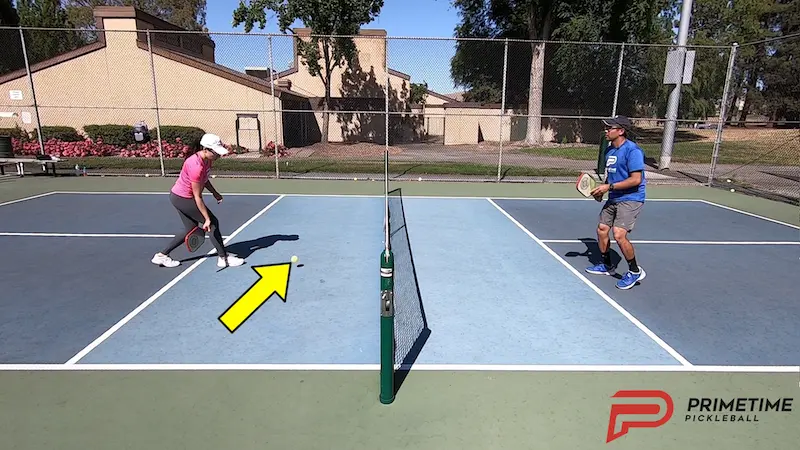
All right so this is the second pro of hitting short unattackable dinks.
Now let’s jump into the cons or the disadvantages of hitting short unattackable dinks.
Con #1 – Hitting Short Dinks Are Slower, And Typically Have Less Spin
Now the first one is hitting short dinks into the non-volley zone are slower and they typically have less spin.
Now because you have to get the ball up and over, for that ball to drop down, it’s going to require more of an arc and that ball is going to be slower.
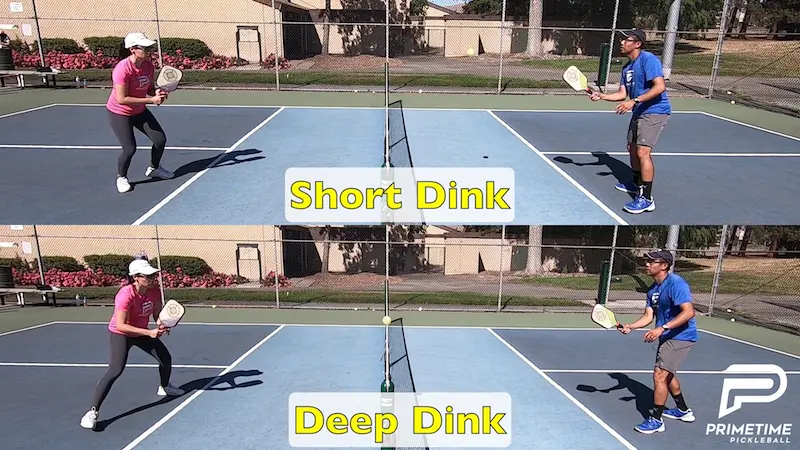
The amount of spin, whether you’re putting side spin, under spin or topspin, for you to make it land really close to the net and land short you’re going to have to hit it with a more flatter shot. So, you’re not going to be able to put as much spin as hitting it deep.
Con #2 – Hitting Short Dinks Is Higher Risk
Con number two, or disadvantage number two – hitting short unattackable dinks is higher risk. You have that net right in front of you.
I can’t tell you how many times I see players trying to aim right over the net and they’re missing the top of the tape or they’re just flat out missing into the net.
Hitting short or shallow dinks can be really high risk.
Con #3 – Hitting Short Dinks Will Not Put Pressure On Your Opponents
The third and final con or disadvantage of hitting short unattackable dinks is that hitting short or shallow dinks into the non-volley zone will not press or put any pressure on your opponent in any way.
Why is this?
Just imagine if i’m hitting all short unattackable dinks into the non-volley zone. My opponent will always be making contact out in front.
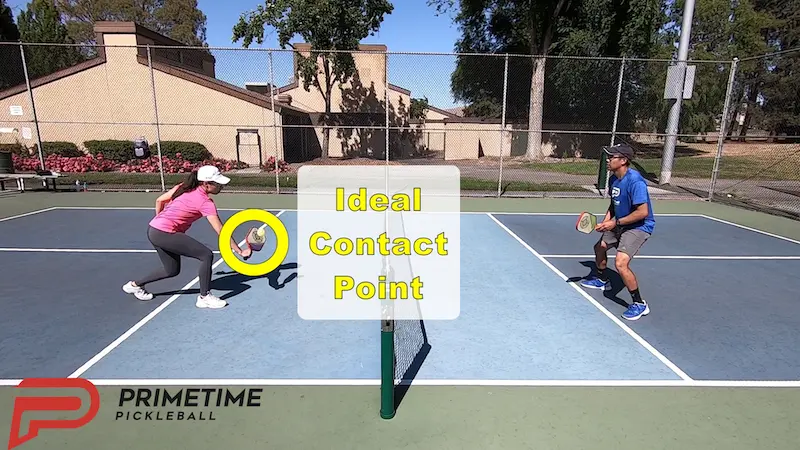
Now, even if the ball is low and close to the net I’m not putting any pressure on them.
Every time that ball goes over they’re going to contact it nice and out in front even though it’s low, and it’s really not going to put any pressure on them.
Even if you’re moving them to the forehand and to the backhand all their contact points are still going to be out in front and they can just bump it right over or they can just really do anything they want with that ball.
So what’s the solution instead of having short shallow unattackable dinks as a winning strategy?
You’ve probably guessed it.
You want to mix it in with deep dinks.
I think deep dinks are a very important and vital aspect of controlling the point and really putting a lot of pressure on your opponents.
Instead of hitting shallow or short dinks into the non-volley zone, I’m suggesting that you utilize hitting deeper dinks closer to that non-volley zone line and sometimes even beyond the non-volley zone line.
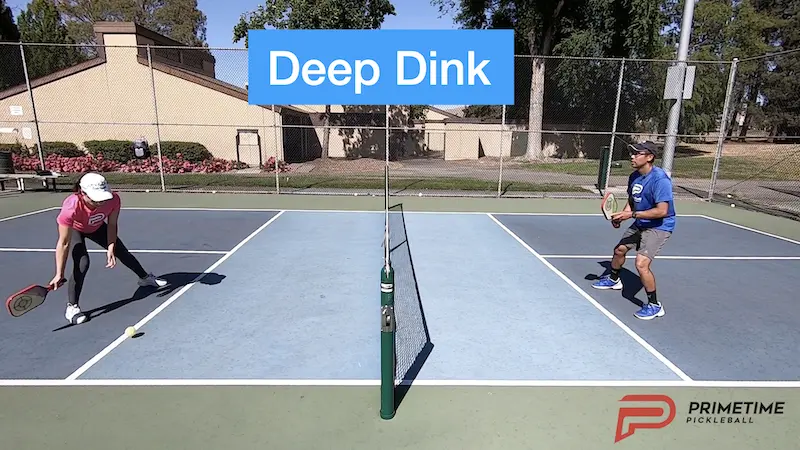
Now let’s go over why this is and why it’s so effective.
Reason For Deep Dinks #1 – By Hitting Deep Dinks, You Will Have More Margin For Error
Now let’s jump into number one – why you should use deep dinks more often is that you will have more margin for error.
As opposed to the short dinks or hitting shallow dinks into the non-volley zone, when you’re hitting deeper dinks you have a better chance of clearing that net.
The only thing with deep dinks is that you can lift them up a little bit and your opponent can maybe attack them if you put it too deep, but you still have the chance to defend or counter attack as opposed to hitting shallow dinks and hitting that ball into the net.
Reason For Deep Dink #2 – Deep Dinks Can Be Hit With More Spin & Pace
Now let’s jump into number two.
By hitting deep dinks you can hit with more spin and more pace. Because your ball and your target is further from you and you’re hitting with a longer trajectory, what that’s going to allow you to do is put more spin and hit the ball with a flatter arc.
You can now use more topspin or underspin, whatever kind of spin you’re putting on the ball, and also hit with a faster dink because, like i said, as opposed to short dinks into the non-volley zone you really have to have a higher arc for that ball to land short.
With deeper dinks you could kind of push it and accelerate that ball and hit it with a more flat trajectory.
That is the second thing that is really really important and that distinguishes hitting short or shallow dinks and deep dinks.
Reason For Deep Dink #3 – Deep Dinks Force Your Opponent To Make Decisions
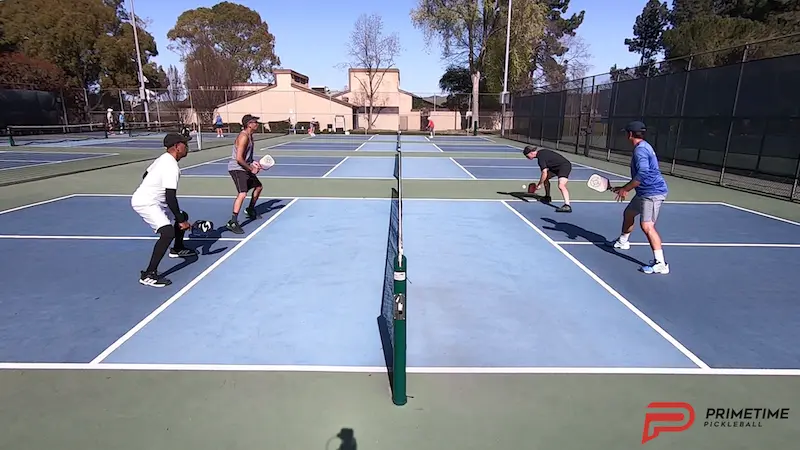
Let’s jump into number three of why hitting deep dinks is so vital and important in controlling the net game. And that is, it’s going to force your opponents to make decisions.
Unlike with the shallow dinks, if you’re hitting dinks that are just over the net you’re not making them make any decisions because they’re just going to contact it out in front.
With mixing in or hitting deeper dinks they have to now think – are they going to hit it out of the air or are they going to step back and let it bounce? Or, are they going to have to hit it as a half a volley?
This decision making is so important especially in higher levels of play.
You’ll notice if you watch the highest levels of play, the pros play, all their dinks or at least 90% of them are deeper dinks and they’re not hitting a lot of shallow dinks. That is because of the decision making aspect.
If you can constantly force your opponents to make decision after decision after decision you know eventually, hopefully, they’ll make a mistake or they’re more prone to making a mistake. Then, you could capitalize on that and put the ball away.
Reason For Deep Dink #4 – Deep Dinks Can Force Bad Contact Points
Number four – why are deep dinks so effective and why do we think you should use them more often is that you can force bad contact points.
Unlike hitting shorter shallow dinks like we said, with the deep dinks you can jam them up and make them contact really close to their body or you can even force contacts on the side of them or even behind them.
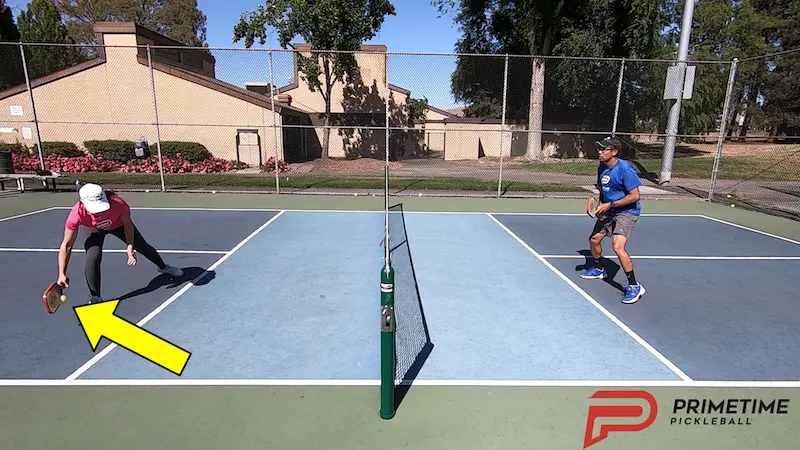
With all these different options, moving the ball around to the forehand and to the backhand, you can really put them in tough spots and force them to hit really tough contact points.
That is going to apply a tremendous amount of pressure because they have to deal with taking it out of the air or letting it bounce or taking it right off the bounce.
They also are trying to get good contact points but when you are forcing and hitting deeper dinks that is going to be a lot harder for them as opposed to always hitting the ball out in front.
Reason For Deep Dink #5 – Deep Dinks Can Push Your Opponents Back
Now let’s jump into number five. That is deep dinks could force your opponent off the line and can back them up.
Unlike shallow dinks, deeper dinks are more penetrating and they are getting to your opponent’s feet and maybe even past their feet. So, hitting deep dinks could really force them off the line if they’re not taking those dinks as volleys.
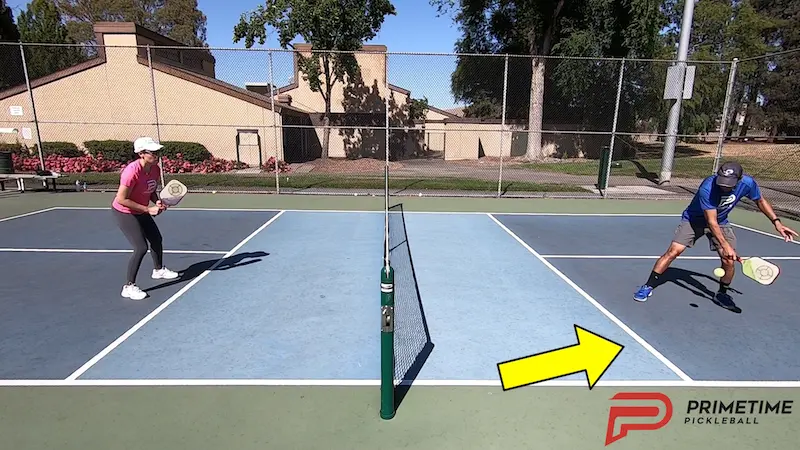
If they are letting that ball drop, it forces them and pushes them more off the line and that gives you more area and more real estate to work with and hit the ball down at their feet.
Reason For Deep Dink #6 – Deep Dinks Can Create Gaps & Space Between Your Opponents
Now let’s jump into the sixth and final one in which we think deep dinks are really effective and that is deep dinks can create gaps and space.
When you are moving your opponent side to side, you’re hitting to their body and you’re also stretching them and forcing them into tough contact points to their forehand and to their backhand – These deep dinks could create gaps between your opponents and it creates more space, more openings, that you can hit through.
So, as you move the ball around force them into tough contact points and create these gaps and spaces then you can really have a chance and opportunity to put the ball away or hit an even tougher shot since there are these openings that previously weren’t there by hitting short unattackable dinks.
Drill
Now that we’ve gone over the importance of utilizing deep dinks this is a really good drill that you can get out there and do with a partner.
I have my wife Katrina on the other side of the net and I set up a couple of cones towards her forehand sids, the blue cones, and a couple of cones towards her backhand side, the orange cones.
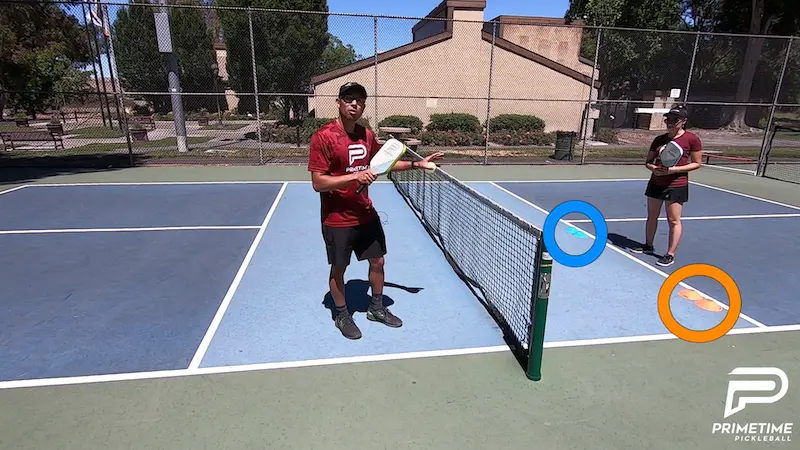
Notice how I didn’t put any in the middle (you could definitely do that if you wanted to). I really want her stretching and reaching, going from side to side, when I’m playing these dinks.
Those are my two targets and I’m going to try to hit them and force her to make that decision – let it bounce or take it out of the air – and then she can hit me a dink anywhere.
We can play a game to five points.
I’ll show you an example right here. (See video at top of post)
Katrina’s goal is to try to guard those cones, try to hold her ground. If she can try to take the ball out of the air and take time away from that’s good for her.
If I hit the cone that’s just a point for me and we’ll play it as a rally and whoever wins the rally will get a point.
It’s a really fun game. It allows me to work on hitting deeper dinks and for her it really works on taking the balls out of the air early so that it helps her make decisions a lot faster.
It works on both sides.
We really hope that you’ve enjoyed this video.
Remember, I’m not suggesting to never ever hit shallow or short dinks into the non-volley zone. I’m just telling you to not use that as a winning pickleball strategy.
There are so many advantages to hitting deeper dinks up to that non-volleys zone line or even past it and which applies a lot of pressure on your opponent.